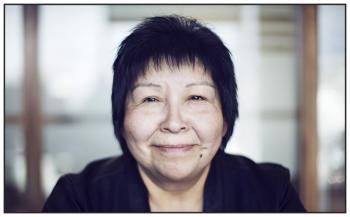Image Caption
Summary
Local Journalism Initiative Reporter
Windspeaker.com
Margaret Kenequanash has had her share of success during the past three decades working with First Nations and tribal councils.
Kenequanash, who became the first female chief of the North Caribou Lake First Nation when she was elected in 1996, is considered a prominent energy executive and Indigenous leader.
She shared some of her work stories this past Thursday, Oct. 28, chosen as the 2021 Goodman School of Business Distinguished Leader for Brock University, which is located in St. Catharines, Ont.
Kenequanash began her day by meeting with some Brock students. And then she participated in a virtual discussion later in the day, a chat which was available to not only students from the university but community members as well.
The Goodman School of Business honours a prominent Canadian business leader every year.
“I hope students will be inspired to think about new, innovative partnership models for the 21st century as they embark on their own careers,” Kenequanash said.
She is the CEO of Wataynikaneyap Power and primarily spoke about the company, which is in the midst of the largest First Nations majority-owned infrastructure project in Canadian history.
The power project, expected to be completed by the end of 2023, is a partnership that includes 24 First Nations. It will reduce diesel generation in 17 remote communities in Ontario.
“Our First Nations have been working on energy for quite a number of years now,” Kenequanash said.
Wataynikaneyap Power, also known as Watay, is building about 1,800 kilometres of transmission lines. Those will be connected to various First Nations communities and eventually bring a total of about 14,000 people to the Ontario power grid.
Investing in a project such as this had been talked about more than two decades ago.
“Our leaders had already identified energy as a regional issue and they had several initiatives that they had worked on to try to create a partnership and pursue what was going to be a transmission project,” Kenequanash said.
While previous plans failed to come to fruition, Kenequanash was able to continue the battle.
“When I take a look at this and what told me to take action on this was… I understood the challenges,” she said. “Without long-term infrastructure and reliable infrastructure in the area, it would be very difficult for our communities to look at other opportunities. Never mind other opportunities but even just to improve the quality of life in the community to provide safe water, shelter and food.”
Kenequanash said it’s important to not only focus on today but the future as well.
“Part of this project is the vision; the vision of how are we going to create our destiny as Indigenous people,” she said. “I believe in the vision of our people. And it’s been supported by our partners.
“It’s not only our Indigenous people. It’s everybody that we need to think about. We can’t think just about tomorrow. I often tell people don’t just think about things up to where your nose is. You’ve got to think beyond that. You’ve got to think 20 years from now. You’ve got to think 40 years from now because we have to be able to leave something for the next generations. We’ve got to become visionaries.”
Providing a clean environment is one way of accomplishing that.
Kenequanash said there were plenty of naysayers when she initiated the current energy venture.
“When we started this project, there was a lot of people that told me that it’s never going to happen,” she said. “There were quite a few people, specifically industry people, that told me I am crazy and that this is never going to happen. That was more of a boost, a challenge for me to make it happen.”
She also realized this project was required.
“Bringing in reliable infrastructure that provides for long-term solutions rather than Band-Aid solutions. It’s something that we needed to look at even though it was overwhelming at times and challenging at times," she said.
“I look at the challenges our communities are facing today, even today as we speak, some of the traumatic experiences that our people have in the community. I think about the children and I think about the Elders and those situations that are caused because they don’t have the proper infrastructure.”
And now more than ever she believes the project was always on the right track.
“I believe that this energy development is precedent setting in bringing reliable energy,” she said. “It’s a huge step forward for the quality of life in the communities and it’s not a Band-Aid solution.”
Local Journalism Initiative Reporters are supported by a financial contribution made by the Government of Canada.

